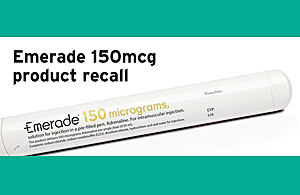
Patients, or carers of patients, who carry Emerade 150 microgram auto-injector pens should return all in-date Emerade 150 micrograms auto-injectors to their local pharmacy once they have obtained a prescription for, and been supplied with, an alternative brand. Emerade 150 microgram is used for the emergency treatment of severe, acute allergic reactions (anaphylaxis) in children.
-
only return your pen when you have received a replacement from your pharmacy which will be an alternative brand - either EpiPen or Jext.
-
ensure that you learn how to use the replacement pen that you have been supplied with, as each brand of pen is used in a different way. Ask your doctor, pharmacist or nurse for help with this. You will also find instructions on how to use your new pen inside the pack it is supplied in, along with details of the manufacturer's website that also provides information, including videos, on how to use your new EpiPen or Jext adrenaline pen.
Recall action has been taken due to reports of difficulty in activating the Emerade pens, meaning a dose of adrenaline cannot be delivered. This defect also affects the 300 and 500 microgram strengths of Emerade adrenaline pens, which will be recalled when sufficient supplies of alternative brands (Epipen and Jext) are available. Patients who have in-date Emerade pens of these other strengths should keep these until the expiry date and should be reassured that available data shows the majority of the pens will still activate. Patients are reminded to follow existing advice to carry two pens with them at all times.
Exposure to high temperature may increase the risk of pen failure. Emerade pens should not be exposed to temperatures above 25°C, such as being placed near to a radiator or fire. If travelling to a hot climate, patients should visit their doctor to obtain a prescription for an alternative brand of adrenaline pen.
If an Emerade pen does need to be used, it should be pressed very firmly against the thigh. If this does not result in activation, the patient should immediately use their second pen. More detailed information for patients is available on the MHRA website. This includes images showing users what an activated pen looks like, compared to a non-activated pen.






